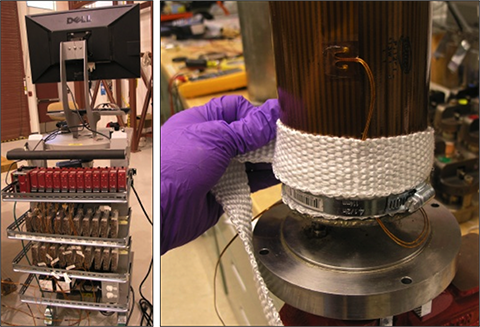MATERIALS RESEARCH
Background
Nuclear reactors present a very challenging service environment. Components within the containment of an operating reactor must tolerate high-temperature water, stress, vibration, and an intense neutron field. Degradation of materials in this environment can lead to reduced performance and, if unmitigated, can lead to failure. Materials degradation in a nuclear power plant is very complex due to the variety of materials, environmental conditions, and stress states. Over 25 different metal alloys can be found within the primary and secondary systems; additional materials exist in concrete, the containment vessel, instrumentation and control equipment, cabling, buried piping, and other support facilities. Dominant forms of degradation may vary greatly between the different systems, structures, and components and can have an important role in the safe and efficient operation of a nuclear power plant.
Extending reactor service lifetimes to and beyond 60 years increases the demands on materials and components. Therefore, an early evaluation of the possible effects of extended lifetime is critical.
 Research and Development Purpose and Goals
Research and Development Purpose and Goals
This pathway supports research and development to develop the scientific basis for understanding and predicting long-term environmental degradation behavior of materials in nuclear power plants. This work will provide data and methods to assess the performance of systems, structures, and components essential to safe and sustained nuclear power plant operations.
The Materials Research Pathway is involved in this research and development activity for the following reasons:
The Materials Research Pathway tasks provide fundamental understanding and mechanistic knowledge via science-based research. Mechanistic studies provide better foundations for prediction tool development and focused mitigation solutions. These studies also are complementary to industry efforts to gain relevant, operational data. The U.S. national laboratory and university systems are uniquely suited to provide this information given their extensive facilities, research experience, and specific expertise.
Selected Materials Research Pathway tasks are focused on development of high-risk, high-reward technologies to understand, mitigate, or overcome materials degradation. This type of alternative technology research is uniquely suited for government roles and facilities. These pursuits also are outside the area of normal interest for industry sponsors due to the risk of failure.
The Materials Research Pathway tasks support collaborative research with industry and regulators (and meet at least one of the above objectives). The focus of these tasks is on supporting and extending industry capability by providing expertise, unique facilities, or fundamental knowledge.
Combined, these thrusts provide high quality measurements of degradation modes, improved mechanistic understanding of key degradation modes, and predictive modeling capability with sufficient experimental data to validate these tools; new methods of monitoring degradation, and development of advanced mitigation techniques to provide improved performance, reliability, and economics.

Reactor Metals
Numerous types of metal alloys can be found throughout the primary and secondary systems of nuclear power plants. Some of these materials (in particular, the reactor internals) are exposed to high temperatures, water, and neutron flux, creating degradation mechanisms in the materials that are unique to reactor service. Research projects in this area will provide a technical foundation to establish the ability of those metals to support extended operations.
Concrete
Large areas of most nuclear power plants have been constructed using concrete and there are some data on performance through the first 40 years of service. In general, the performance of reinforced concrete structures in nuclear power plants has been very good. Incidents of degradation initially reported generally occurred early in the life of the structures and primarily have been attributed to construction/design deficiencies or improper material selection. Although the vast majority of these structures will continue to meet their functional or performance requirements during the current and any future licensing periods, it is reasonable to assume that there will be isolated examples where as a result primarily of environmental effects, the structures may not exhibit the desired durability (e.g., water-intake structures and freezing/thawing damage of containments) without some form of intervention.
Cabling
Cable aging mechanisms and degradation is an important area of study. The plant operators carry out periodic cable inspections using NDE techniques to measure degradation and determine when replacement is needed. Degradation of these cables is primarily caused by long-term exposure to high temperatures. Additionally, stretches of cables that have been buried underground are frequently exposed to groundwater. Wholesale replacement of cables is likely economically undesirable for plant operation beyond 60 years.
 Mitigation Technologies
Mitigation Technologies
Mitigation technologies include weld repair, post-irradiation annealing, and water chemistry modifications. Welding is widely used for component repair. Weld-repair techniques must be resistant to long-term degradation mechanisms. Extended lifetimes and increased repair frequency welds must be resistant to corrosion, irradiation, and other forms of degradation. The purpose of this research area is to develop new welding techniques, weld analysis, and weld repair. A critical assessment of the most advanced methods and their viability for LWR repair weld applications is needed. Post-irradiation annealing may be a means of reducing irradiation-induced hardening in the RPV. Water chemistry modification is another mitigation technology that warrants evaluation.